Santa’s in the channel country
Host: Mudgeacca Station
Written by Claire Britton, Station Manager
I am 5th generation Britton in this area and to me, seeing Santa Gertrudis cows out in the paddock is just second nature. The breed itself originates from a Shorthorn cross with Red Brahman, so I guess it’s a good combination on paper too. But just like every breed, if bad traits aren’t culled out you will end up with an ordinary line and I believe bull selecting for your females is a massive key which gets overlooked too often.
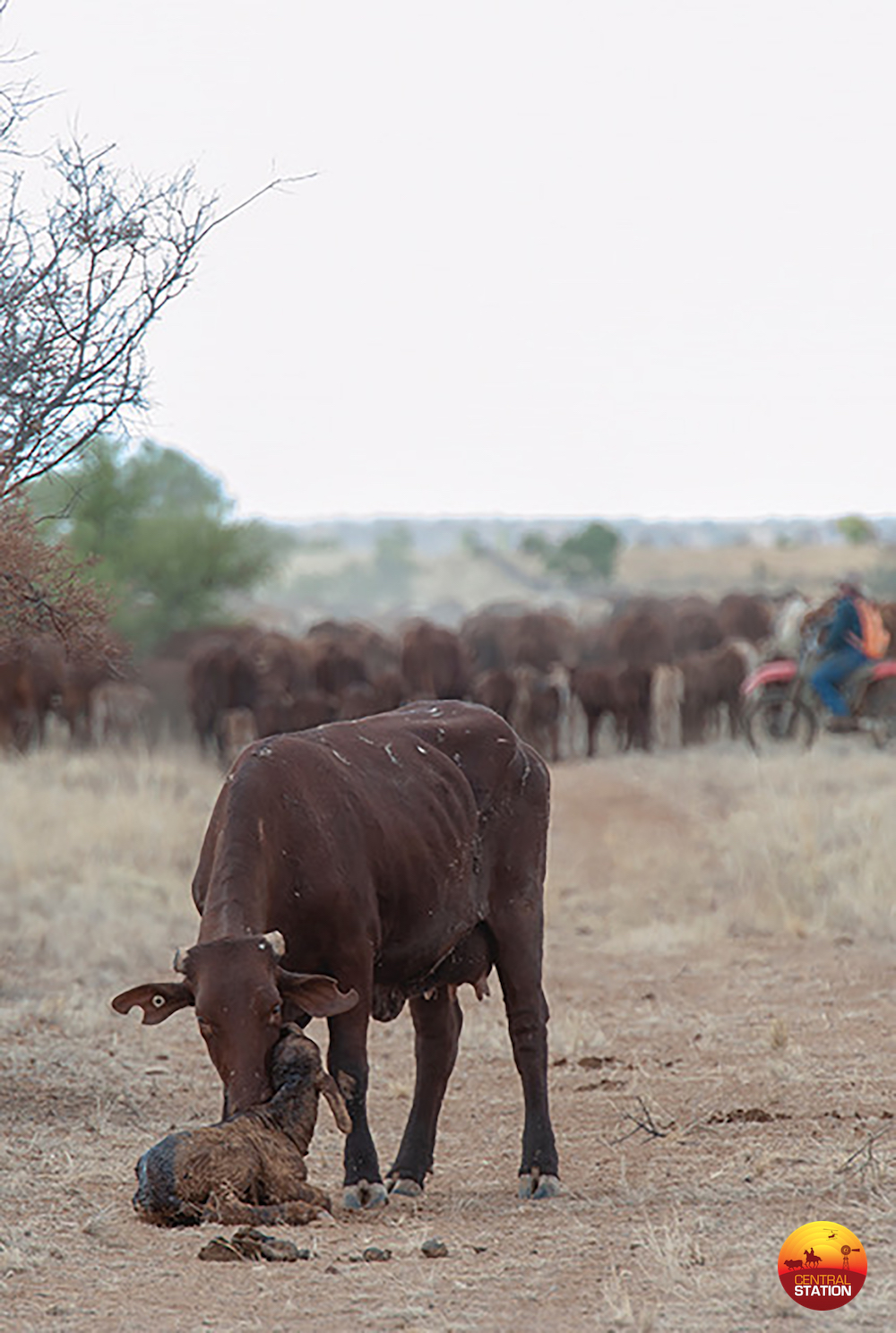 A young Santa Gertrudis cows attentively licks her new born calf, she is a good Mum staying with her new born and not fussed about the bike that is continuing to walk the remaining mob away.
A young Santa Gertrudis cows attentively licks her new born calf, she is a good Mum staying with her new born and not fussed about the bike that is continuing to walk the remaining mob away.
I’ve been asked what my favourite breed is before and it’s honestly a tough question as I do like a lot of breeds, but Brahman’s come out on top for sure. I love the red brahman’s but the greys are the winners in my eyes. Ask me the same question 12 years ago though and Brahman’s would’ve been at the bottom of my list!
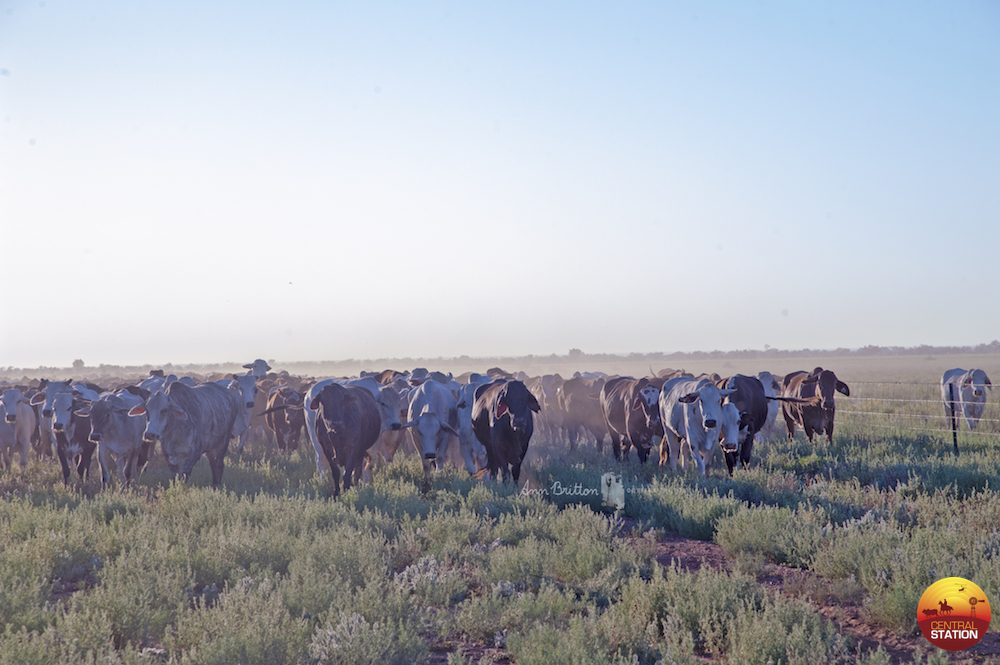 A line of our Brahman crossbreds and ‘bought’ cows.
A line of our Brahman crossbreds and ‘bought’ cows.
I grew up with cattle, animals in general, and they have been a part of my entire life. I remember as a kid we would buy old ‘shit box’ Brahman cows from the Gulf and they’d come off the truck with big racks (sets of horns), looking run out and small framed. If they had calves they looked like poddies and better off without mum altogether. So, my first impression of Brahman’s as a whole was pretty glim and I wondered why anyone would want to breed them. Funnily enough my first paid job out of school after graduating in 2006, was at a Brahman stud property that ran commercial mobs as well. I then went on to work for two more families that breed Brahmans too, and then I was just hooked on them. I was lucky enough to be involved in showing and bull sales with them as well and soon discovered they smell like fairy floss when being brushed!
 Cheeky red calf checking out the ute on a water run.
Cheeky red calf checking out the ute on a water run.
I came home at the end of 2013, back to the Santa’s with a pretty fresh outlook on life and the beef industry. Dad loves his Herefords as well, and uses one of our blocks to purely cross our Santa line of breeders with Herefords, and the steers we sell with that cross are awesome to see. It’s a known thing that colour and bally faces are the toughest things to breed out, even the fourth cross with a bally face might still hit the ground with a white sock or star. Cross breeding cattle isn’t for the faint hearted and you don’t just cross certain breeds for 12 months and expect the impact and traits to be bred out in the same length of time.
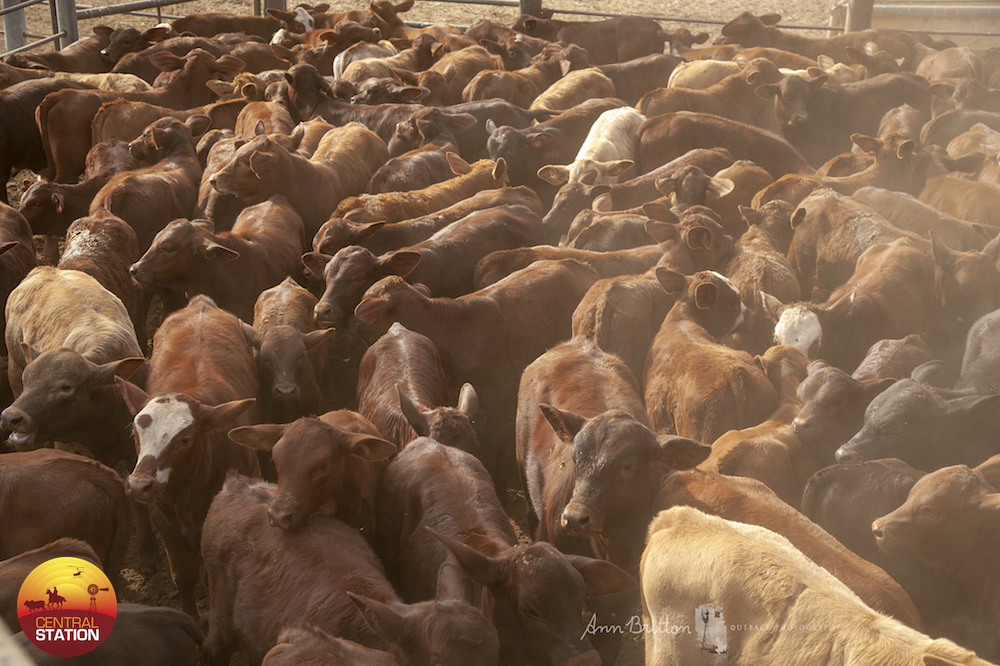 An array of red’s in the branding pen.
An array of red’s in the branding pen.
Our rule is on average 1 bull to maximum 50 cows, so in a mob of 300 cows we would have minimum 6 bulls running with them. Although the genetics of each calf is 50/50 to the cow and bull, that one bull has a large genetic influence on your mob. So, you want him to be on the money to produce good all round calves, and Mum also needs to meet standards. If a bull throws a bad temper, his 50 calves could be having you up the rail before they are even weaned, not something to aim for. Bull selection and cow culling is very important.
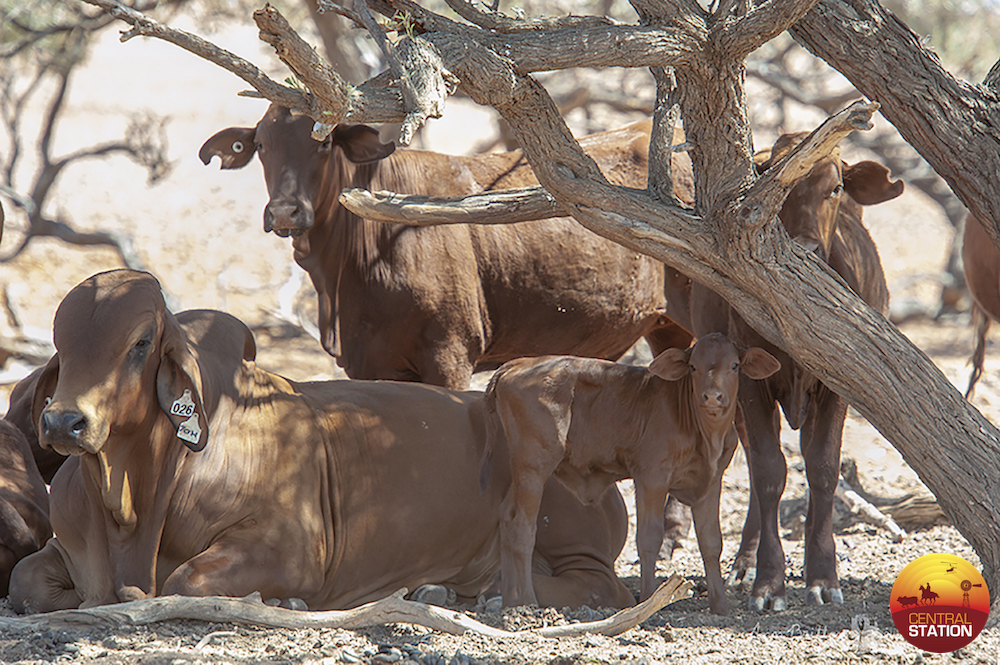 A red Brahman bull that is joined with our first calving heifers is content under the shade of gidgee.
A red Brahman bull that is joined with our first calving heifers is content under the shade of gidgee.
The idea of keeping the red colour with the progeny appeals to me so I’ve been allowed to broaden the cross breeding with Red Brangus, one pure Red Angus bull and we came across the Jarrah Red line from Banana, QLD a few years ago now and have great success with the Droughtmaster, red Brahman cross they provide. I did choose some black Brangus bulls too, and their calves have been great, although I think the craze with black cattle has been and gone for now, although they are a nice cross for us still.
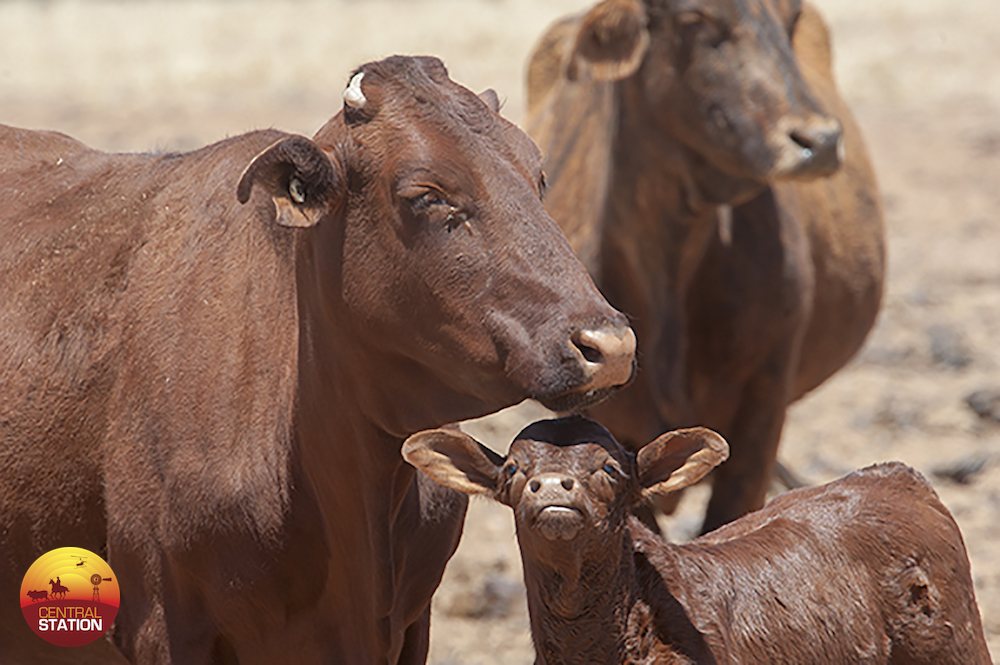 One of our Santa Gertrudis cows with her cheeky calf.
One of our Santa Gertrudis cows with her cheeky calf.
Getting into the nitty gritty, a polled bull does appeal to me, but he also has to have the other important traits such as sound bone structure, fertility, clean sheath, length, ease of calving for our girls and of course good temperament. I am well aware that the dehorning of cattle is frowned upon by an increasing amount of our consumers. Although necessary for both the animal and us as handlers, I think getting more polled calves on the ground is very doable. We are finding the percentage of polled calves on the ground are increasing each year, so it’s a slow process, but it sure makes branding time easy and the animal itself isn’t losing any other quality as a beef animal.
Dehorning isn’t pretty, you can’t hide from the fact that it’s bloody and that animal will indeed feel pain, but if you know what you’re doing, it’s a quick process and will only need doing once in that animals life. There is advancing products out there now to be used for pain relief and of course to minimise bleeding and clot the wound quicker.
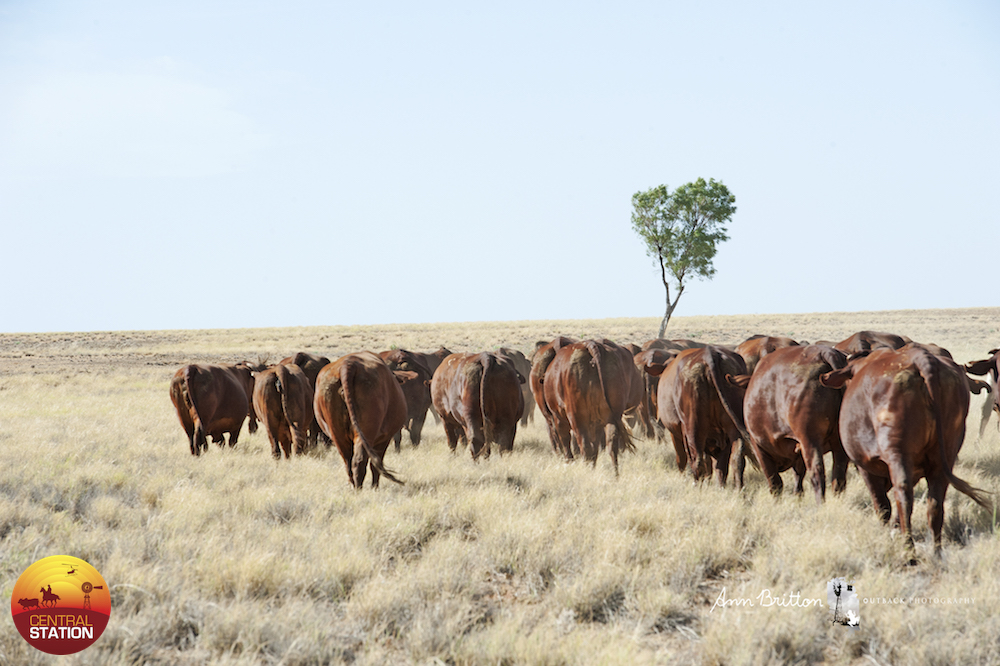 Red cattle in our landscapes can walk out well to feed on pasture and maintain condition.
Red cattle in our landscapes can walk out well to feed on pasture and maintain condition.
As weaners we just box the females and males together to settle, then get them in for another draft a couple of months down the track. With our females we generally cull for colour, we do buy breeders in and they can be all different colours and shapes, therefore their progeny follow suit.
We keep a nice red line from our females, but of course they still need to have sound structure, look fertile and have good temperament. They are then grown out and once they get to an average weight we join them with Brahman bulls for the first calf. We’ve just found Brahman bulls give our first calf heifers ease of calving. If they come in without a calf at foot and not in calf then we strongly consider culling them. Females are at their peak fertility when they are young, so if they aren’t falling in calf by 2 years old, then their breeding ability for the rest of their life is dim. A female not producing a calf is just dead grass to us, so she may as well be sold if in good condition and be someone’s dinner.
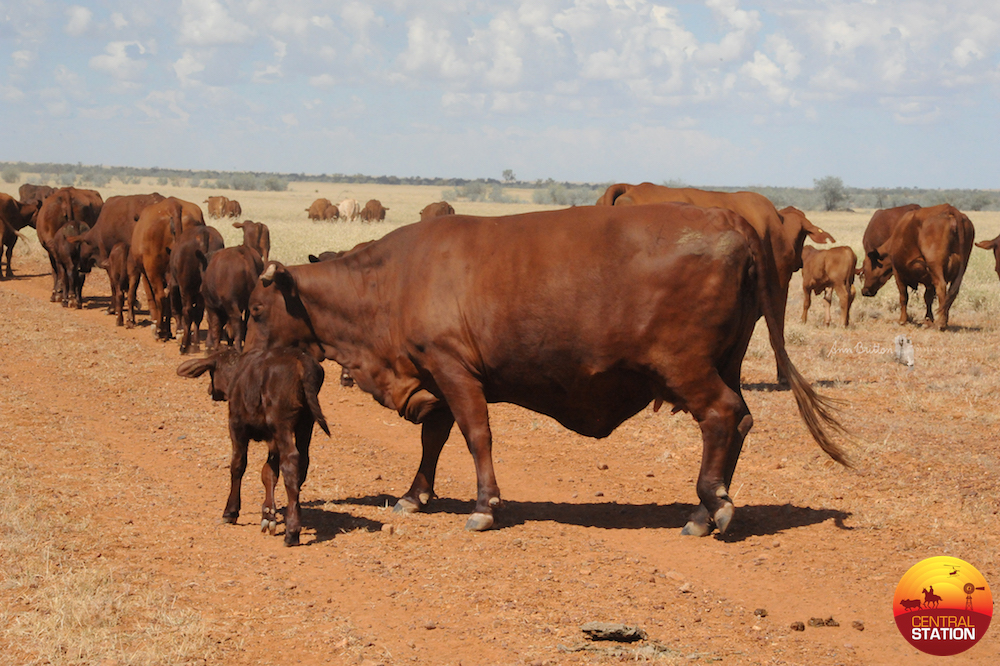 Shiney, good condition red cows and their calves walking along, this cow in particular is showing she is a good Mum checking on her calf at the tail of the mob. Santa’s are renown to be good mothers.
Shiney, good condition red cows and their calves walking along, this cow in particular is showing she is a good Mum checking on her calf at the tail of the mob. Santa’s are renown to be good mothers.
Each breed has their good and bad qualities, we just find that the Santa’s work for us and the landscape. They have a great ability to walk out to feed when it starts getting dry and they are unreal mothers, giving 100% to their calves. A cow will get poor and lose condition feeding her calf and the calf will be fat, sappy, energetic and growing. This is why 2 rounds mustering is important to us to wean the calves otherwise the cows will just keep giving and giving and run themselves into the ground. They are also good protective mothers and a good cow will just walk along in a mob staying with their calf. A calf will always walk along better when they know Mum is there! We are proud of our Santa’s in the channel country and they’ve got us through some unforgivable droughts over the years and keep hitting the bell come sale time.
